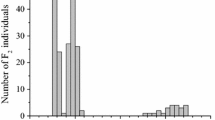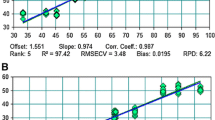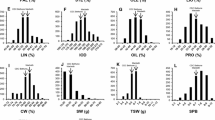Abstract
Increased stearic acid (C18:0) content in the seed oil of sunflower would improve the oil quality for some edible uses. The sunflower line CAS-20 (C18:0 genotype Es1Es1es2es2), developed from the high C18:0 mutant line CAS-3 (C18:0 genotype es1es1es2es2; 25% C18:0), shows increased C18:0 levels in its seed oil (8.6%). The objective of this research was to map quantitative trait loci (QTL) conferring increased C18:0 content in CAS-20 in an F2 mapping population developed from crosses between HA-89 (wild type Es1Es1Es2Es2; low C18:0) and CAS-20, which segregates independently of the macromutation Es1 controlling high C18:0 content in CAS-3. Seed oil fatty acid composition was measured in the F2 population by gas-liquid chromatography. A genetic linkage map of 17 linkage groups (LGs) comprising 80 RFLP and 19 SSR marker loci from this population was used to identify QTL controlling fatty acid composition. Three QTL affecting C18:0 content were identified on LG3, LG11, and LG13, with all alleles for increased C18:0 content inherited from CAS-20. In total, these QTL explained 43.6% of the C18:0 phenotypic variation. Additionally, four candidate genes (two stearate desaturase genes, SAD6 and SAD17, and a FatA and a FatB thioesterase gene) were placed on the QTL map. On the basis of positional information, QTL on LG11 was suggested to be a SAD6 locus. The results presented show that increased C18:0 content in sunflower seed oil is not a simple trait, and the markers flanking these QTL constitute a powerful tool for plant breeding programs.
Similar content being viewed by others
References
Ascherio A. and Willett W.C. 1997. Health effects of trans fatty acids. Am. J. Clin. Nutr. 66 (suppl.): 1006S–1010S.
Berry S.T., Allen R.J., Barnes S.R. and Caligari P.D.S. 1994. Molecular analysis of Helianthus annuus L. 1. Restriction length polymorphism between inbred lines of cultivated sunflower. Theor. Appl. Genet. 89: 435–441.
Berry S.T., Leon A.J., Hanfrey C.C., Challis P., Burkholz A., Barnes S.R., Rufener G.K., Lee M. and Caligari P.D.S. 1995. Molecular marker analysis of Helianthus annuus L. 2. Construction of an RFLP linkage map for cultivated sunflower. Theor. Appl. Genet. 91: 195–199.
Berry S.T., Leon A.J., Challis P., Livini C., Jones R., Hanfrey C.C., Griffiths S. and Roberts A. 1996. Construction of a high density, composite RFLP linkage map for cultivated sunflower (Helian-thus annuus L.). In: Proc 14th Int. Sunflower Conf., Beijing/ Shenyang, China, pp. 1155–1160.
Berry S.T., Leon A.J., Peerbolte R., Challis P., Livini C., Jones R. and Feingold S. 1997. Presentation of the Advanta sunflower RFLP linkage map for public research. In: Proc 19th Sunflower Research Workshop, Fargo, USA, pp. 113–118.
Bohn M., Khairallah M.M., González-de-león D., Hoisington D.A., Utz H.F., Deutsch J.A., Jewell D.C., Mihm J.A. and Melchinger A.E. 1996. QTL mapping in tropical maize: I. Genomic regions affecting leaf feeding resistance to sugarcane borer and other traits. Crop Sci. 36: 1352–1361.
Cantisán S., Martínez-Force E. and Garcés R. 2000. Enzymatic studies of high stearic acid sunflower seed mutants. Plant Physiol. Biochem. 38: 377–382.
Churchill G.A. and Doerge R.W. 1994. Empirical threshold valued for quantitative trait mapping. Genetics 138: 963–971.
Doerge R.W. and Churchill G.A. 1996. Permutation tests for multiple loci affecting a quantitative character. Genetics 142: 285–294.
Facciotti M.T., Bertain P. and Yuan L. 1999. Improved stearate phenotype in transgenic canola expressing a modified acyl-acyl carrier protein thioesterase. Nature Biotech. 17: 593–597.
Falconer D.S. 1989. Introduction to quantitative genetics, 3rd edn. Longman Group, London, UK, 340 pp.
Gentzbittel L., Vear F., Zhang Y.X., Bervillé A. and Nicolas P. 1995. Development of a consensus linkage RFLP map of culti-vated sunflower (Helianthus annuus L.). Theor. Appl. Genet. 90: 1079–1086.
Haley C.S. and Knott S.A. 1992. A simple regression method for mapping quantitative trait loci in line crosses using flanking markers. Heredity 69: 315–324.
Hawkins D.J. and Kridl J.C. 1998. Characterization of acyl-ACP thioesterases of mangosteen (Garcinia mangostana) seed and high levels of stearate production in transgenic canola. Plant J. 13: 743–752.
Hongtrakul V., Slabaugh M.B. and Knapp S. 1998. DFLP, SSCP and SSR markers for Δ-9-stearoyl-acyl carrier protein desaturases strongly expressed in developing seeds of sunflower: Intron lengths are polymorphic among elite inbred lines. Mol. Breed. 4: 195–203.
Jansen R.C. and Stam P. 1994. High resolution of quantitative traits into multiple loci via interval mapping. Genetics 136: 1447–1455.
Jones A., Davies H.M. and Voelker T.A. 1995. Palmitoyl-acyl carrier protein (ACP) thioesterase and the evolutionary origin of plant acyl-ACP thioesterases. Plant Cell 7: 359–371.
Knutzon D.S., Thompson G.A., Radke S.E., Johnson W.B. and Knauf V.C. 1992. Modification of Brassica seed oil by antisense expression of a stearoyl-acyl carrier protein desaturase gene. Proc. Natl. Acad. Sci. USA 89: 2624–2628.
Kritchevsky D., Tepper S.A., Kuksis A., Eghtedary K. and Klurfeld D.M. 1995. Influence of triglyceride structure on experimental arteriosclerosis. Fed. Am. Soc. Exp. Biol. J. 9: A320.
Lander E., Green P., Abrahanson J., Barlow A., Daley M., Lincoln S. and Newburg L. 1987. MAPMAKER: an interactive computer package for constructing primary genetic linkage maps of experimental and natural populations. Genomics 1: 174–181.
Martínez-Force E., Cantisán S., Serrano-Vega M.J. and Garcés R. 2000. Acyl-acyl carrier protein thioesterase activity from sunflower (Helianthus annuus L.) seeds. Planta 211: 673–678.
Osorio J., Fernández-Martínez J.M., Mancha M. and Garcés R. 1995. Mutant sunflowers with high concentration of saturated fatty acids in the oil. Crop Sci. 35: 739–742.
Paniego N., Echaide M., Muñoz M., Fernández L., Torales S., Faccio P., Fuxan I., Carrera M., Zandomeni R., Suárez E.Y. and Hopp H.E. 2002. Microsatellite isolation and characterisation in sunflower (Helianthus annuus L.). Genome 45: 34–43.
Pearson T.A. 1994. Stearic acid and cardiovascular disease-answer and questions. Am. J. Clin. Nut. 60: 1017–1072.
Pérez-Vich B., Garcés R. and Fernández-Martínez J.M. 1999. Genetic control of high stearic acid content in the seed oil of sunflower mutant CAS-3. Theor. Appl. Genet. 99: 663–669.
Pérez-Vich B., Fernández-Martínez J.M., Grondona M., Knapp S.J. and Berry S.T. 2002. Stearoyl-ACP and oleoyl-PC desaturase genes cosegregate with quantitative trait loci underlying high stearic and high oleic acid mutant phenotypes in sunflower. Theor. Appl. Genet. 104: 338–349.
Pérez-Vich B., Muñoz-Ruz J. and Fernández-Martínez J.M. 2004. Developing mid-stearic acid sunflower lines from a high stearic acid mutant. Crop Sci. 44: 70–75.
Snedecor G.W. and Cochran W.G. 1989. Statistical Methods. 8th edition. Iowa State University Press, Iowa, EEUU.
Somerville C., Browse J.A., Jaworski J.G. and Ohlrogge J.B. 2000. Lipids. In: Buchanan B.B., Gruissem W. and Jones R.L. (eds), Biochemistry and Molecular Biology of Plants. American Society of Plant Physiologists, Rockville, Maryland, EEUU, pp. 456–526.
Tang S., Yu J.K., Slabaugh M., Shintani D.K. and Knapp S.J. 2002. Simple sequence repeat map of the sunflower genome. Theor. Appl. Genet. 105: 1124–1136.
Utz H.F. and Melchinger A.E. 1996. PLABQTL: A program for composite interval mapping of QTL. J. Quant Trait Loci 2 (1).
Voelker T.A., Jones A., Cranmer A.M., Davies H.M. and Knutzon D.S. 1997. Broad-range and binary-range-acyl-carrier-protein thioesterases suggest an alternative mechanism for medium-chain production in seeds. Plant Physiol. 114: 669–677.
Yu J.K., Tang S., Slabaugh M.B., Heesacker A., Cole G., Herring M., Soper J., Han F., Chu W.C., Webb D.M., Thompson L., Edwards K.J., Berry S., Leon A.J., Olungu C., Maes N. and Knapp S.J. 2003. Towards a saturated molecular genetic linkage map for cultivated sunflower. Crop Sci. 43: 367–387.
Zeng Z.B. 1994. Precision mapping of quantitative trait loci. Genetics 136: 1457–1468.
Author information
Authors and Affiliations
Corresponding author
Rights and permissions
About this article
Cite this article
Pérez-Vich, B., Knapp, S.J., Leon, A.J. et al. Mapping minor QTL for increased stearic acid content in sunflower seed oil. Molecular Breeding 13, 313–322 (2004). https://doi.org/10.1023/B:MOLB.0000034081.40930.60
Issue Date:
DOI: https://doi.org/10.1023/B:MOLB.0000034081.40930.60




